Blast-Resistant Performance of Hybrid Fiber-Reinforced Concrete (HFRC) Panels Subjected to Contact Detonation
Abstract
Featured Application
Abstract
1. Introduction
2. HFRC Preparation and Characterization
2.1. Mix Proportions
2.2. Concrete Production
2.3. Static Test for Characterization
3. Explosion Test Program
3.1. Contact Detonation Test Setup
3.2. Damaged HFPC Panels
3.2.1. Control Specimen
3.2.2. PP-Steel HFRC Specimen
3.2.3. PVA-Steel HFRC Specimen
3.3. Blast-Resistance Performance
3.4. Fiber-Hybrid Effect Evaluation
4. Conclusions
- (1)
- The significant improvement of compressive strength, flexural strength and blast resistance can be achieved by fiber reinforcement. The fiber reinforcement transfers the mechanical responses from brittleness to ductility.
- (2)
- Steel fiber addition can better improve the compressive strength, flexural strength and blast resistance than PP or PVA-fiber counterparts. The SEM test suggests that the steel fiber tends to pull out from the matrix with few cementitious particles adhering.
- (3)
- Contact detonation induces both front and rear surface craters. The rear crater dimension tends to be larger than the front crater because of the reflected tensile stress wave, resulting in severer damage on the rear free surface.
- (4)
- Compared with Steel FRC control specimen, PP-Steel and PVA-Steel HFRC cannot improve blast-resistant performance except for 1.5% steel + 0.5% PP hybrid fiber reinforcement.
- (5)
- For both PP-Steel and PVA-Steel HFRC, the best blast-resistant performance is achieved at around 1.5% steel + 0.5% polymer-fiber hybrid.
- (6)
- All the hybrid fiber mixes exhibit negative hybrid effect. PP-fiber has an advantage over PVA-fiber in terms of fiber-hybrid effect on blast-resistance improvement.
Author Contributions
Funding
Acknowledgments
Conflicts of Interest
References
- Yoo, D.-Y.; Banthia, N. Mechanical and structural behaviors of ultra-high-performance fiber-reinforced concrete subjected to impact and blast. Constr. Build. Mater. 2017, 149, 416–431. [Google Scholar] [CrossRef]
- Feng, J.; Sun, W.; Liu, Z.; Cui, C.; Wang, X. An armour-piercing projectile penetration in a double-layered target of ultra-high-performance fiber reinforced concrete and armour steel: Experimental and numerical analyses. Mater. Des. 2016, 102, 131–141. [Google Scholar] [CrossRef]
- Wang, Z.; Shi, Z.; Wang, J. On the strength and toughness properties of sfrc under static-dynamic compression. Compos. Part B Eng. 2011, 42, 1285–1290. [Google Scholar] [CrossRef]
- Abdallah, S.; Fan, M.; Rees, D.W. Bonding mechanisms and strength of steel fiber–reinforced cementitious composites: Overview. J. Mater. Civ. Eng. 2018, 30, 04018001. [Google Scholar] [CrossRef]
- Strieder, E.; Aigner, C.; Petautschnig, G.; Horn, S.; Marcon, M.; Schwenn, M.; Zeman, O.; Castillo, P.; Wan-Wendner, R.; Bergmeister, K. Strengthening of reinforced concrete beams with externally mounted sequentially activated iron-based shape memory alloys. Materials 2019, 12, 345. [Google Scholar] [CrossRef]
- Feng, J.; Sun, W.; Wang, X.; Shi, X. Mechanical analyses of hooked fiber pullout performance in ultra-high-performance concrete. Constr. Build. Mater. 2014, 69, 403–410. [Google Scholar] [CrossRef]
- Liu, J.; Han, F.; Cui, G.; Zhang, Q.; Lv, J.; Zhang, L.; Yang, Z. Combined effect of coarse aggregate and fiber on tensile behavior of ultra-high performance concrete. Construct. Build. Mater. 2016, 121, 310–318. [Google Scholar] [CrossRef]
- Simões, T.; Octávio, C.; Valença, J.; Costa, H.; Costa, D.D.; Júlio, E. Influence of concrete strength and steel fibre geometry on the fibre/matrix interface. Compos. Part B Eng. 2017, 122, 156–164. [Google Scholar] [CrossRef]
- Li, P.; Brouwers, H.; Yu, Q. Influence of key design parameters of ultra-high performance fibre reinforced concrete on in-service bullet resistance. Int. J. Impact Eng. 2020, 136, 103434. [Google Scholar] [CrossRef]
- Zhang, W.; Chen, S.; Zhang, N.; Zhou, Y. Low-velocity flexural impact response of steel fiber reinforced concrete subjected to freeze–thaw cycles in nacl solution. Constr. Build. Mater. 2015, 101, 522–526. [Google Scholar] [CrossRef]
- Hong, K.; Lee, S.; Han, S.; Yeon, Y. Evaluation of fe-based shape memory alloy (fe-sma) as strengthening material for reinforced concrete structures. Appl. Sci. 2018, 8, 730. [Google Scholar] [CrossRef]
- Picazo, Á.; Alberti, M.G.; Gálvez, J.C.; Enfedaque, A.; Vega, A.C. The size effect on flexural fracture of polyolefin fibre-reinforced concrete. Appl. Sci. 2019, 9, 1762. [Google Scholar] [CrossRef]
- Liu, J.; Wu, C.; Su, Y.; Li, J.; Shao, R.; Chen, G.; Liu, Z. Experimental and numerical studies of ultra-high performance concrete targets against high-velocity projectile impacts. Eng. Struct. 2018, 173, 166–179. [Google Scholar] [CrossRef]
- Shaikh, F.U.A.; Luhar, S.; Arel, H.S.; Luhar, I. Performance evaluation of ultrahigh performance fibre reinforced concrete—A review. Constr. Build. Mater. 2020, 232, 117152. [Google Scholar] [CrossRef]
- Su, H.; Xu, J.; Ren, W. Mechanical properties of ceramic fiber-reinforced concrete under quasi-static and dynamic compression. Mater. Des. 2014, 57, 426–434. [Google Scholar] [CrossRef]
- Hsie, M.; Tu, C.; Song, P. Mechanical properties of polypropylene hybrid fiber-reinforced concrete. Mater. Sci. Eng. A 2008, 494, 153–157. [Google Scholar] [CrossRef]
- Singh, N.K.; Rai, B. A review of fiber synergy in hybrid fiber reinforced concrete. J. Appl. Eng. Sci. 2018, 8, 41–50. [Google Scholar] [CrossRef]
- Ramezanianpour, A.A.; Esmaeili, M.; Ghahari, S.A.; Najafi, M.H. Najafi, Laboratory study on the effect of polypropylene fiber on durability, and physical and mechanical characteristic of concrete for application in sleepers. Constr. Build. Mater. 2013, 44, 411–418. [Google Scholar] [CrossRef]
- Ali, M.; Soliman, A.; Nehdi, M. Hybrid-fiber reinforced engineered cementitious composite under tensile and impact loading. Mater. Des. 2017, 117, 139–149. [Google Scholar] [CrossRef]
- Yao, W.; Li, J.; Wu, K. Mechanical properties of hybrid fiber-reinforced concrete at low fiber volume fraction. Cem. Concr. Res. 2003, 33, 27–30. [Google Scholar] [CrossRef]
- Szelkag, M. Mechano-physical properties and microstructure of carbon nanotube reinforced cement paste after thermal load. Nanomaterials 2017, 7, 267. [Google Scholar] [CrossRef] [PubMed]
- Sivakumar, A.; Santhanam, M. Mechanical properties of high strength concrete reinforced with metallic and non-metallic fibres. Cem. Concr. Compos. 2007, 29, 603–608. [Google Scholar] [CrossRef]
- Ding, Y.; Li, D.; Zhang, Y.; Azevedo, C. Experimental investigation on the composite effect of steel rebars and macro fibers on the impact behavior of high performance self-compacting concrete. Constr. Build. Mater. 2017, 136, 495–505. [Google Scholar] [CrossRef]
- Song, W.; Yin, J. Hybrid effect evaluation of steel fiber and carbon fiber on the performance of the fiber reinforced concrete. Materials 2016, 9, 704. [Google Scholar] [CrossRef]
- Shah, A.A.; Ribakov, Y. Recent trends in steel fibered high-strength concrete. Mater. Des. 2011, 32, 4122–4151. [Google Scholar] [CrossRef]
- Su, Y.; Li, J.; Wu, C.; Wu, P.; Tao, M.; Li, X. Mesoscale study of steel fibre-reinforced ultra-high performance concrete under static and dynamic loads. Mater. Des. 2017, 116, 340–351. [Google Scholar] [CrossRef]
- Sun, X.; Zhao, K.; Li, Y.; Huang, R.; Ye, Z.; Zhang, Y.; Ma, J. A study of strain-rate effect and fiber reinforcement effect on dynamic behavior of steel fiber-reinforced concrete. Constr. Build. Mater. 2018, 158, 657–669. [Google Scholar] [CrossRef]
- Sim, J.; Park, C. Characteristics of basalt fiber as a strengthening material for concrete structures. Compos. Part B Eng. 2005, 36, 504–512. [Google Scholar] [CrossRef]
- Martínez-Pérez, I.; Valivonis, J.; Šalna, R.; Cobo-Escamilla, A. Experimental study of flexural behaviour of layered steel fibre reinforced concrete beams. J. Civ. Eng. Manag. 2017, 23, 806–813. [Google Scholar] [CrossRef]
- Jin, C.; Buratti, N.; Stacchini, M.; Savoia, M.; Cusatis, G. Lattice discrete particle modeling of fiber reinforced concrete: Experiments and simulations. Eur. J. Mech. A/Solids 2016, 57, 85–107. [Google Scholar] [CrossRef]
- Olivito, R.S.; Zuccarello, F.; Zuccarello, A. An experimental study on the tensile strength of steel fiber reinforced concrete. Compos. Part B 2010, 41, 246–255. [Google Scholar] [CrossRef]
- Bažant, Z.P.; Rasoolinejad, M.; Dönmez, A.; Luo, W. Dependence of fracture size effect and projectile penetration on fiber content of frc. In IOP Conference Series: Materials Science and Engineering; IOP Publishing: Bristol, UK, 2019; Volume 596, p. 012001. [Google Scholar]
- Habel, K.; Gauvreau, P. Response of ultra-high performance fiber reinforced concrete (uhpfrc) to impact and static loading. Cem. Concr. Compos. 2008, 30, 938–946. [Google Scholar] [CrossRef]
- Nili, M.; Afroughsabet, V. Combined effect of silica fume and steel fibers on the impact resistance and mechanical properties of concrete. Int. J. Impact Eng. 2010, 37, 879–886. [Google Scholar] [CrossRef]
- Nia, A.A.; Hedayatian, M.; Nili, M.; Sabet, V.A. An experimental and numerical study on how steel and polypropylene fibers affect the impact resistance in fiber-reinforced concrete. Int. J. Impact Eng. 2012, 46, 62–73. [Google Scholar]
- Feng, J.; Sun, W.; Zhai, H.; Wang, L.; Dong, H.; Wu, Q. Experimental study on hybrid effect evaluation of fiber reinforced concrete subjected to drop weight impacts. Materials 2018, 11, 2563. [Google Scholar] [CrossRef]
- Yusof, M.A.; Nor, N.M.; Ismail, A.; Peng, N.C.; Sohaimi, R.M.; Yahya, M.A. Performance of hybrid steel fibers reinforced concrete subjected to air blast loading. Adv. Mater. Sci. Eng. 2013, 2013, 420136. [Google Scholar] [CrossRef]
- Feng, J.; Gao, X.; Li, J.; Dong, H.; He, Q.; Liang, J.; Sun, W. Penetration resistance of hybrid-fiber-reinforced high-strength concrete under projectile multi-impact. Constr. Build. Mater. 2019, 202, 341–352. [Google Scholar] [CrossRef]
- Lai, J.; Sun, W.; Xu, S.; Yang, C. Dynamic properties of reactive powder concrete subjected to repeated impacts. ACI Mater. J. 2013, 110, 463–472. [Google Scholar]
- Banthia, N.; Sheng, J. Fracture toughness of micro-fiber reinforced cement composites. Cem. Concr. Compos. 1996, 18, 251–269. [Google Scholar] [CrossRef]
- Sedan, D.; Pagnoux, C.; Smith, A.; Chotard, T. Mechanical properties of hemp fibre reinforced cement: Influence of the fibre/matrix interaction. J. Eur. Ceram. Soc. 2008, 28, 183–192. [Google Scholar] [CrossRef]
- Mahmud, G.H.; Yang, Z.; Hassan, A.M.T. Experimental and numerical studies of size effects of ultra high performance steel fibre reinforced concrete (uhpfrc) beams. Constr. Build. Mater. 2013, 48, 1027–1034. [Google Scholar] [CrossRef]
- Yap, S.P.; Alengaram, U.J.; Jumaat, M.Z. Jumaat, Enhancement of mechanical properties in polypropylene–and nylon–fibre reinforced oil palm shell concrete. Mater. Des. 2013, 49, 1034–1041. [Google Scholar] [CrossRef]
- Zhang, X.; Yang, X.; Chen, Z.; Deng, G. Explosion spalling of reinforced concrete slabs with contact detonations. J. Tsinghua Univ. (Sci. Technol.) 2006, 46, 15–18. [Google Scholar]




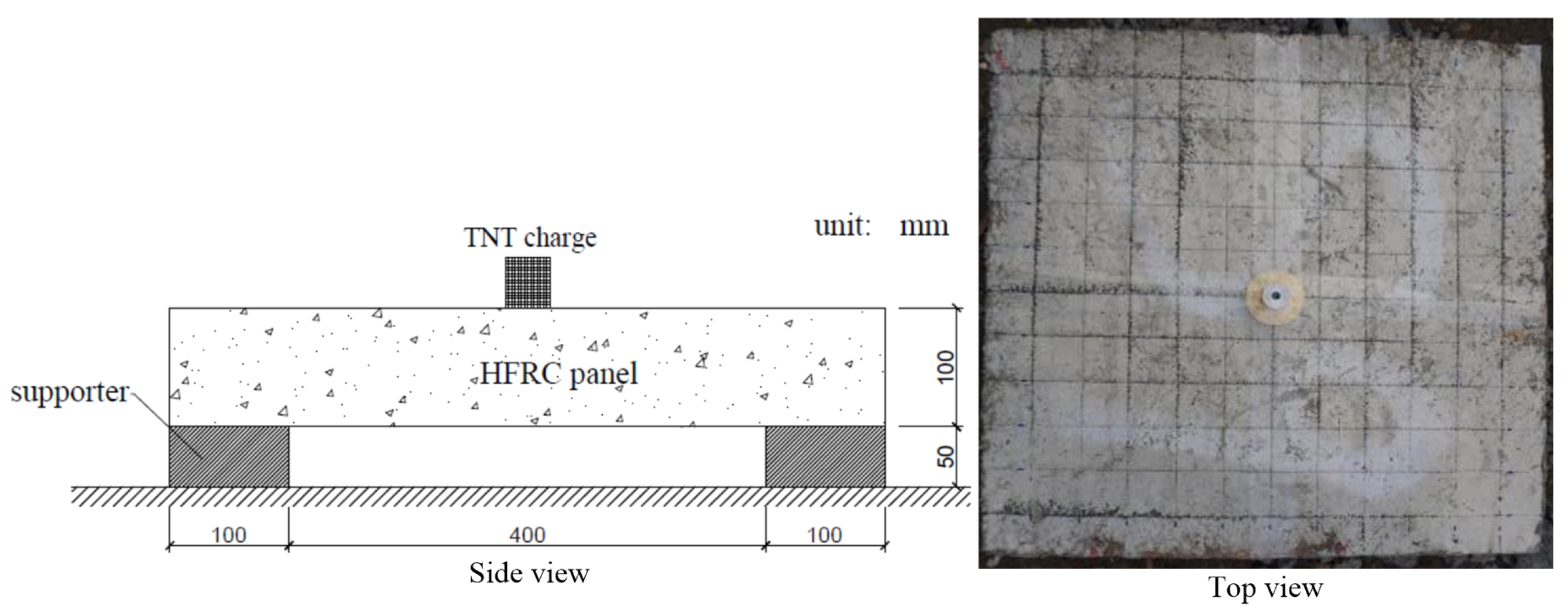
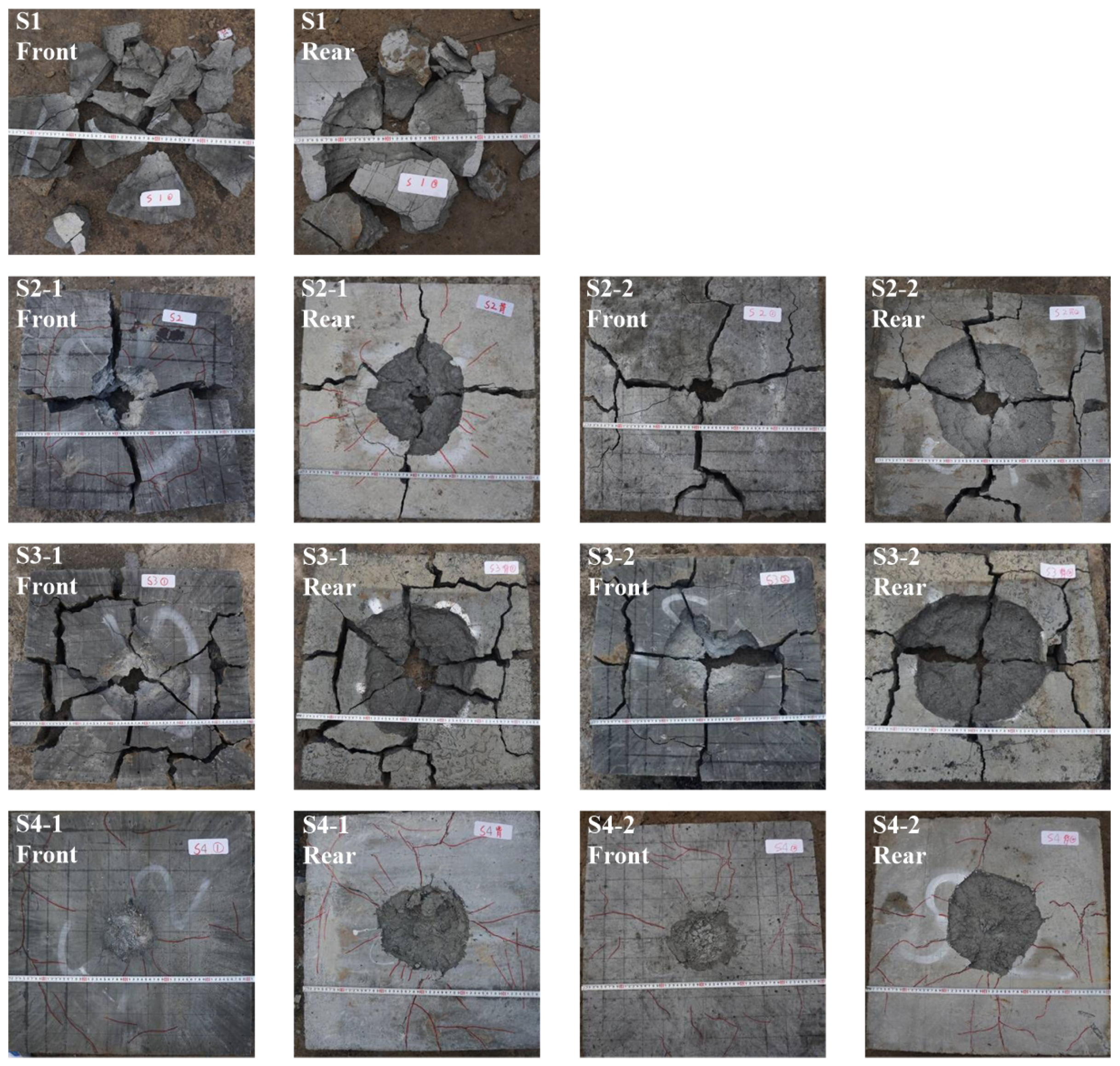
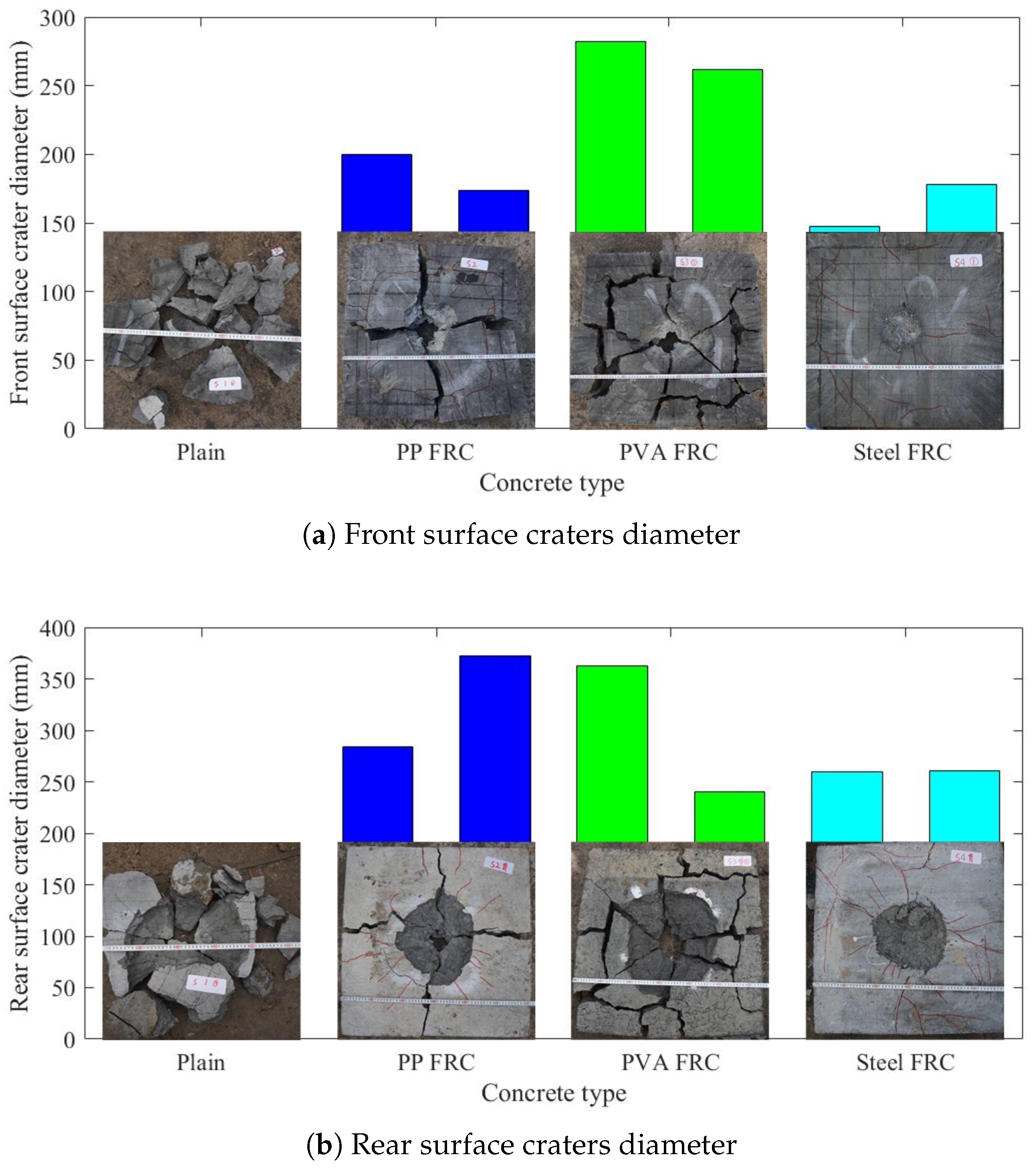

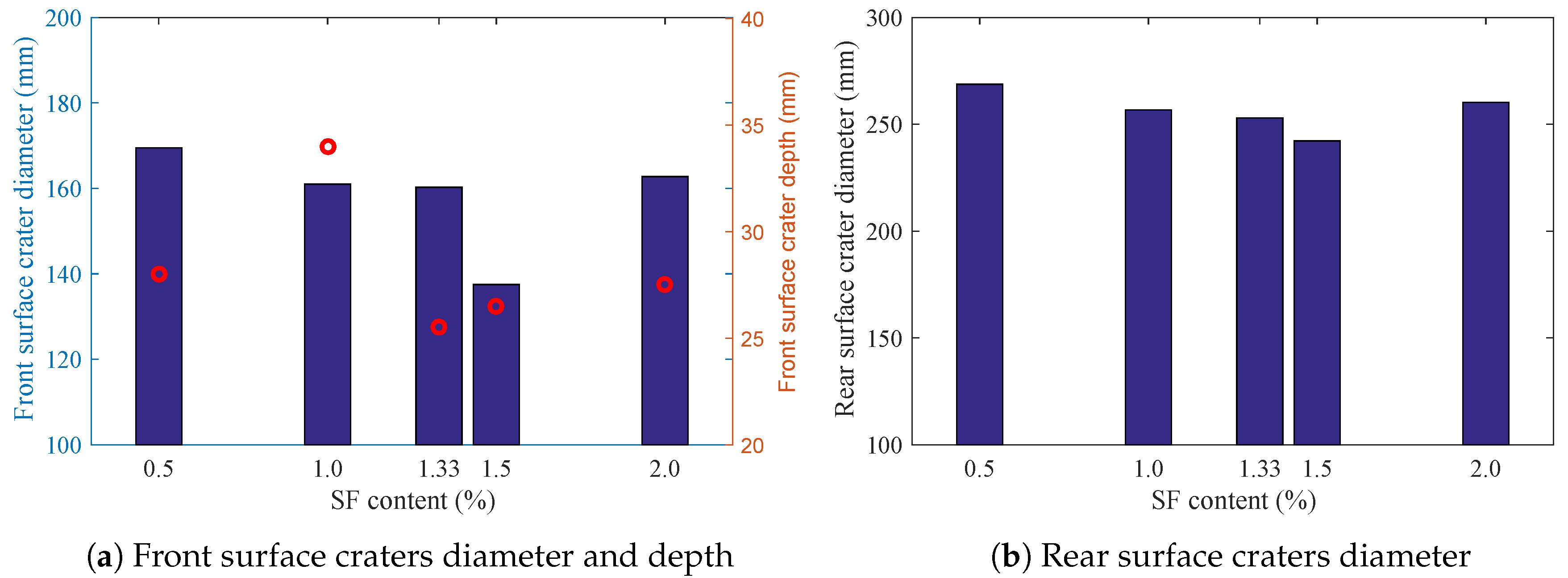
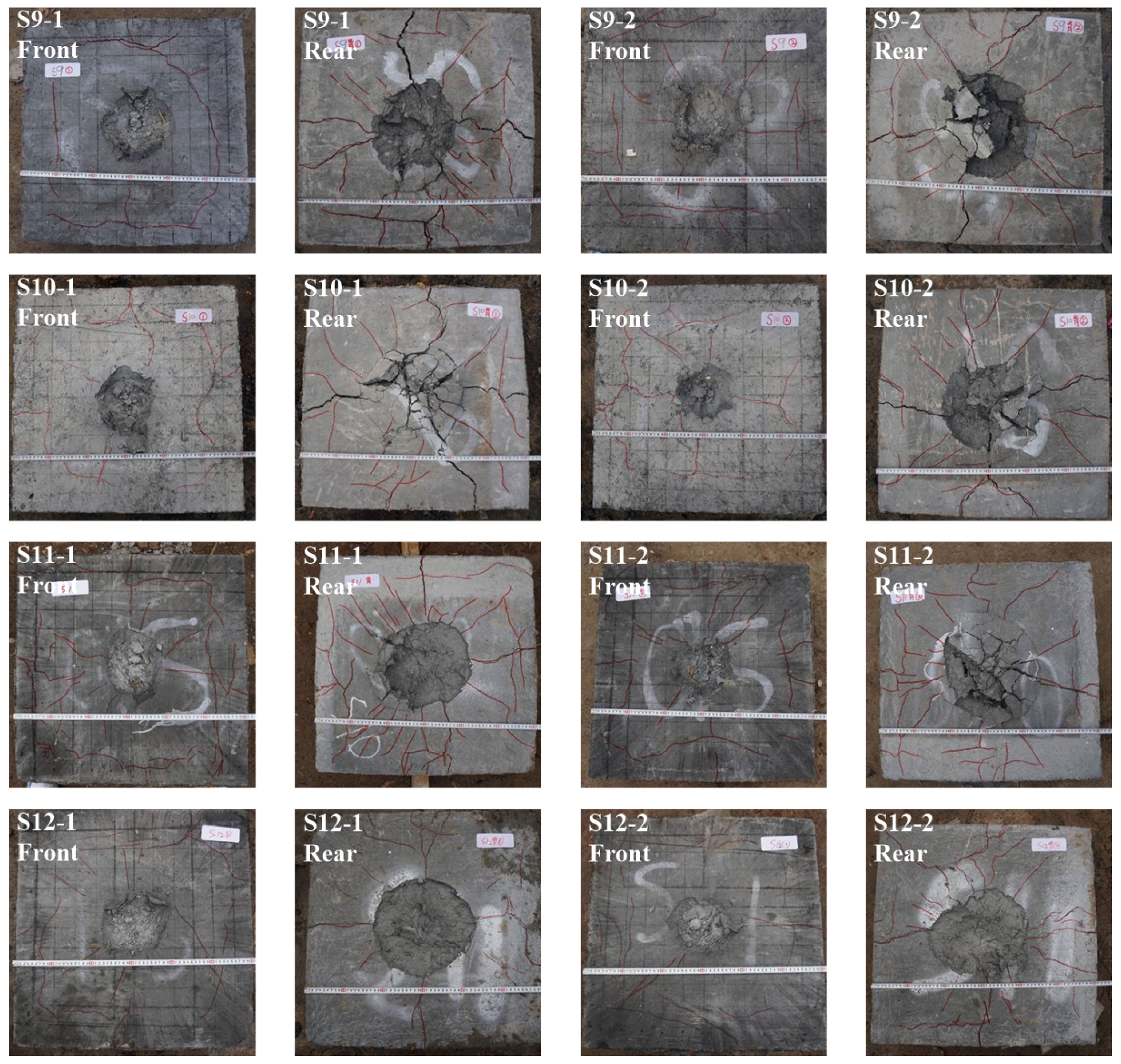




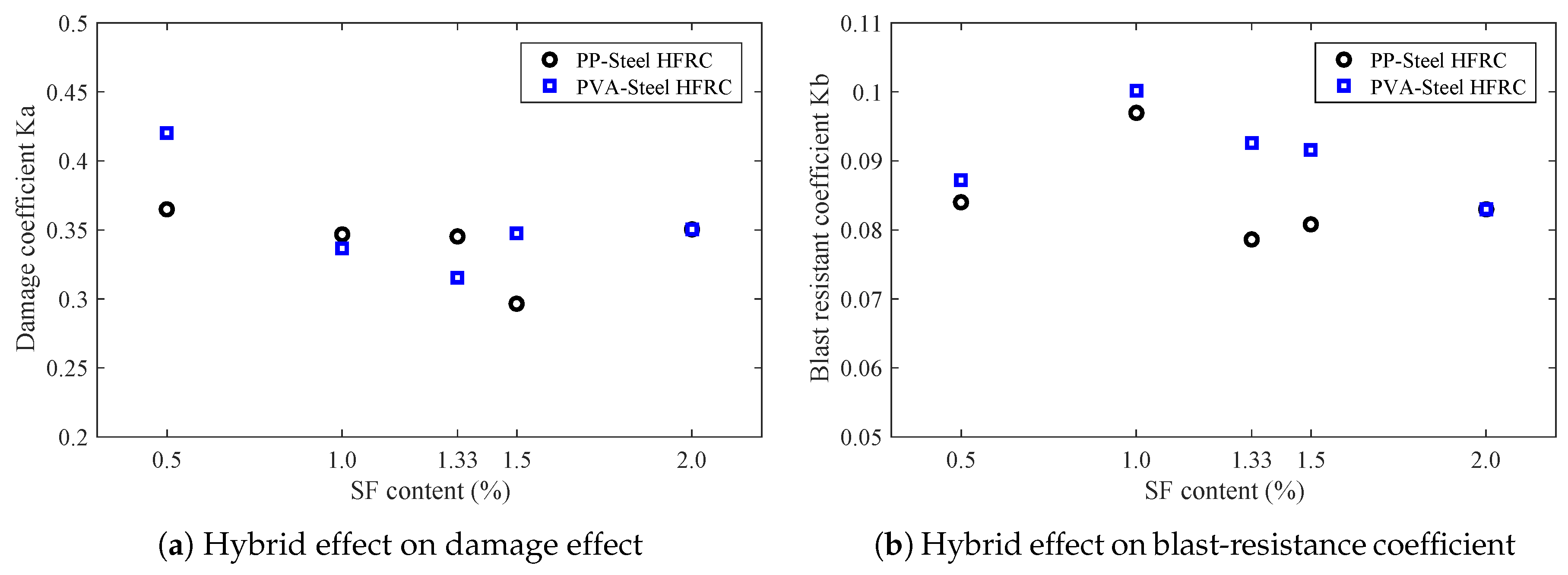
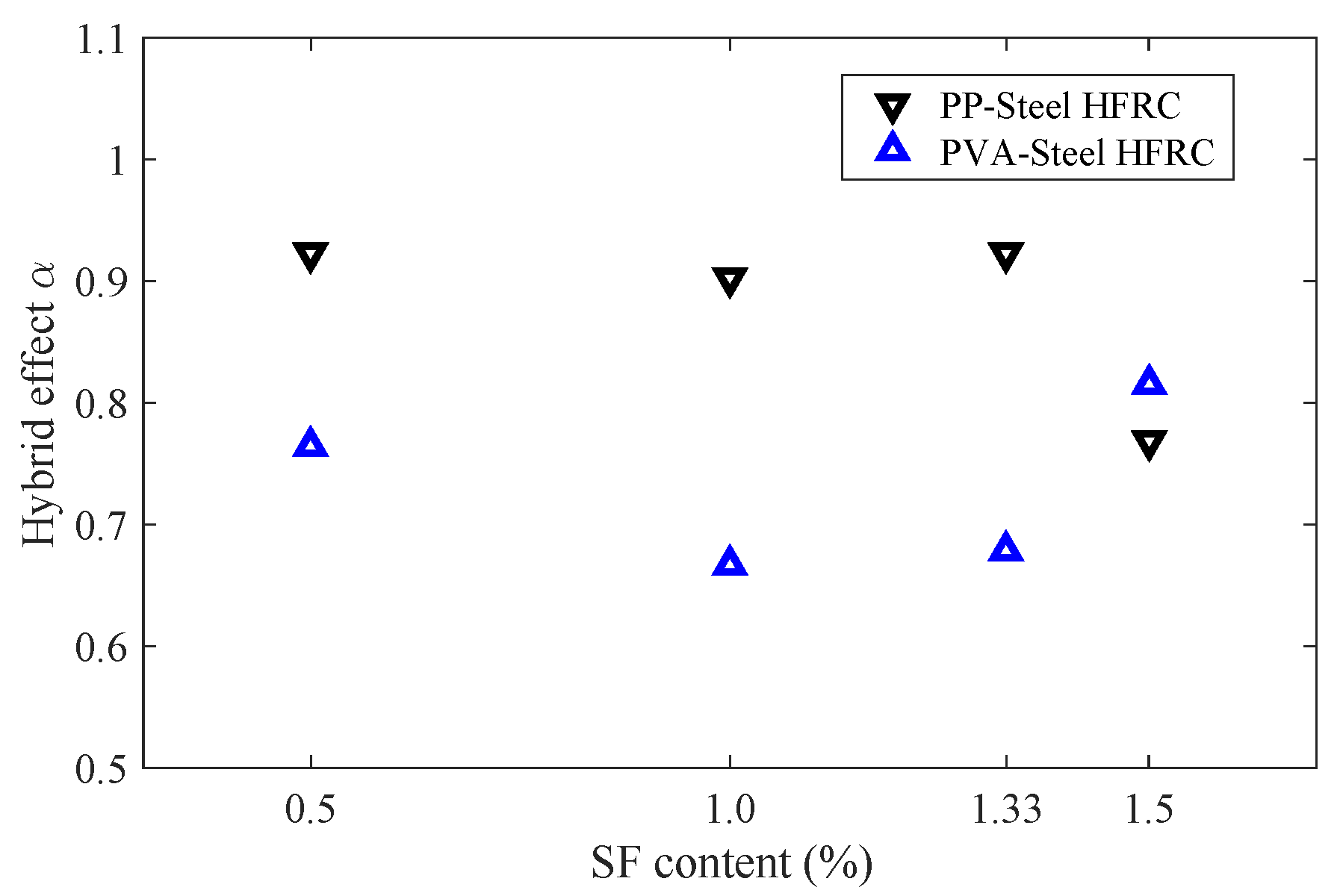
| Item | Cement | Fly Ash | Water | Quartz Sand |
|---|---|---|---|---|
| kg/m3 | 1165.9 | 145.7 | 327.9 | 590.2 |
| Fiber Type | Diameter (μm) | Length (mm) | Density (g/cm3) | Tensile Strength (MPa) | Elastic Modulus (GPa) |
|---|---|---|---|---|---|
| PP | 30 | 15–18 | 0.91 | 270 | 3 |
| PVA | 30 | 12–15 | 1.30 | 1000 | 8 |
| Steel | 220 | 12–14 | 7.85 | 1200 | 200 |
| No. | Steel Fiber | PP-Fiber | PVA-Fiber |
|---|---|---|---|
| S1 | 0 | 0 | 0 |
| S2 | 0 | 2% | 0 |
| S3 | 0 | 0 | 2% |
| S4 | 2% | 0 | 0 |
| S5 | 0.5% | 1.5% | 0 |
| S6 | 1.0% | 1.0% | 0 |
| S7 | 1.33% | 0.67% | 0 |
| S8 | 1.5% | 0.5% | 0 |
| S9 | 0.5% | 0 | 1.5% |
| S10 | 1.0% | 0 | 1.0% |
| S11 | 1.33% | 0 | 0.67% |
| S12 | 1.5% | 0 | 0.5% |
| No. | Front Crater Diameter | Front Crater Depth | Rear Crater Diameter |
|---|---|---|---|
| S1-1 | - | - | - |
| S1-2 | - | - | - |
| S2-1 | 200/200 | - | 247/320 |
| S2-2 | 177/170 | - | 372/372 |
| S3-1 | 245/320 | - | 336/390 |
| S3-2 | 234/289 | - | 207/273 |
| S4-1 | 139/156 | 20 | 230/290 |
| S4-2 | 152/204 | 33 | 241/280 |
| No. | Front Crater Diameter | Front Crater Depth | Rear Crater Diameter |
|---|---|---|---|
| S5-1 | 166/185 | 32 | 249/271 |
| S5-2 | 149/178 | 23 | 265/290 |
| S6-1 | 158/160 | 26 | 280/293 |
| S6-2 | 155/171 | 30 | 203/251 |
| S7-1 | 169/181 | 35 | 224/266 |
| S7-2 | 142/149 | 33 | 247/275 |
| S8-1 | 130/150 | 25 | 240/240 |
| S8-2 | 135/135 | 26 | 214/275 |
| No. | Front Crater Diameter | Front Crater Depth | Rear Crater Diameter |
|---|---|---|---|
| S9-1 | 205/205 | 35 | 207/273 |
| S9-2 | 185/185 | 24 | 267/275 |
| S10-1 | 143/143 | 38 | 249/334 |
| S10-2 | 153/186 | 33 | 249/268 |
| S11-1 | 120/170 | 32 | 222/270 |
| S11-2 | 140/155 | 32 | 254/290 |
| S12-1 | 149/181 | 32 | 260/260 |
| S12-2 | 142/173 | 31 | 221/281 |
© 2019 by the authors. Licensee MDPI, Basel, Switzerland. This article is an open access article distributed under the terms and conditions of the Creative Commons Attribution (CC BY) license (http://creativecommons.org/licenses/by/4.0/).
Share and Cite
Yao, W.; Sun, W.; Shi, Z.; Chen, B.; Chen, L.; Feng, J. Blast-Resistant Performance of Hybrid Fiber-Reinforced Concrete (HFRC) Panels Subjected to Contact Detonation. Appl. Sci. 2020, 10, 241. https://doi.org/10.3390/app10010241
Yao W, Sun W, Shi Z, Chen B, Chen L, Feng J. Blast-Resistant Performance of Hybrid Fiber-Reinforced Concrete (HFRC) Panels Subjected to Contact Detonation. Applied Sciences. 2020; 10(1):241. https://doi.org/10.3390/app10010241
Chicago/Turabian StyleYao, Wenjin, Weiwei Sun, Ze Shi, Bingcheng Chen, Le Chen, and Jun Feng. 2020. "Blast-Resistant Performance of Hybrid Fiber-Reinforced Concrete (HFRC) Panels Subjected to Contact Detonation" Applied Sciences 10, no. 1: 241. https://doi.org/10.3390/app10010241
APA StyleYao, W., Sun, W., Shi, Z., Chen, B., Chen, L., & Feng, J. (2020). Blast-Resistant Performance of Hybrid Fiber-Reinforced Concrete (HFRC) Panels Subjected to Contact Detonation. Applied Sciences, 10(1), 241. https://doi.org/10.3390/app10010241





